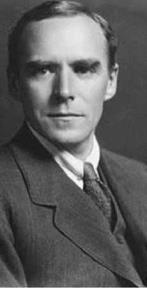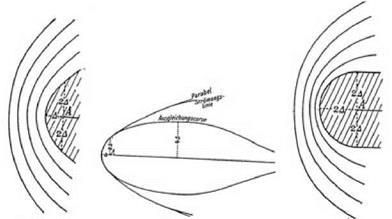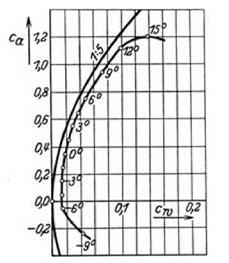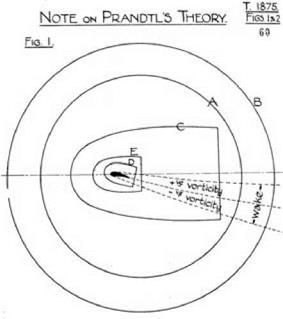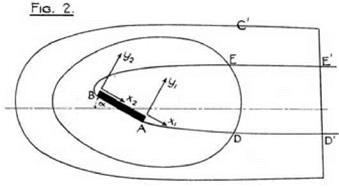Glauert versus Taylor
There was clearly a desire by the members of the Aeronautical Research Committee to put the theory of circulation and Prandtl’s analysis of the finite wing to the test, but disagreement emerged about how to proceed. This gave rise to a sequence of technical reports in which Taylor and Glauert crossed swords. Part of the problem concerned experimental technique. A further difficulty was that Glauert was sensitive to the fundamental distinction between the ideas underlying the two-dimensional picture of Kutta flow (that is, flow that is smooth at the trailing edge) and Prandtl’s three-dimensional picture of the wing as a lifting line with trailing vortices. Glauert wanted these ideas kept distinct, while other participants in the discussion ran these two ideas together and counted them as forming one single theory whose basic assumption was the irrotational character of the flow.
To explain what was at issue it is necessary to go back to December 1921 and the mathematical report submitted by Muriel Barker.4 She had suggested that the theoretical streamlines she had plotted for the flow over a Joukowsky aerofoil with circulation could be the basis for an experimental test: “it would be most instructive,” she had written, “if these same quantities could be obtained practically” (3). Miss Barker’s report and the question of what to do next were discussed by the Aerodynamics Sub-Committee and by the full Research Committee during February and March 1922.5 Should they follow her suggestion and place a model of a Joukowsky aerofoil in a wind channel or should they use a more practical aerofoil, for example, the RAF 15? If they used a real section then should they ask Miss Barker to generate the theoretical streamlines by tedious computation or could a quicker method be found? Were mechanical or electrical methods of generating the theoretical streamlines of comparable accuracy to those produced by the laborious calculations that would be needed? Lamb was in favor of using the Joukowsky profile and direct calculation. Southwell wanted to use a more realistic profile and a mechanical method. He mentioned that Taylor had developed a piece of apparatus that enabled him to use a soap film to model the potential surfaces of ideal fluid flow. Bairstow added that he and Sutton Pippard had devised graphical methods for solving Laplace’s equation.6 Then there was the possibility of using the techniques developed by Hele-Shaw derived from photographs of creeping flow. It was decided that Southwell and Taylor would report back on different analogue methods of producing theoretical streamlines.
Southwell started with his report T. 1696.7 He supported Muriel Barker’s suggestion that comparisons be made of theoretical and empirical streamlines for an infinite wing, that is, where the model wing would reach right across the tunnel to exclude the effect of flow around the tips. In this way, said Southwell, “a direct check can be imposed upon one of the fundamental assumptions of the Prandtl theory” (2). Southwell then described the method developed by Taylor for simulating the streamlines and the bench-top apparatus that had been built.8 A soap film was stretched between the walls of a box while precise measurements were made of the position of the film. The film connected the outline of a small wing profile to other boundaries within the confines of the box. (These boundaries represented the walls of the wind tunnel.) Southwell explained how this technique could take into account the circulation as well as automatically correcting for the effect in the flow of the tunnel walls. “Using orthodox mathematical methods,” said Southwell, “it would appear that the problem thus presented is one of extreme difficulty”
(2) . Taylor, however, followed this up with a brief note, designated T. 1696a, in which he said that he had actually applied the soap-film method to a model aerofoil but had not taken the matter further.9 The small size of the apparatus prevented the measurements being made with the required accuracy. Taylor therefore backed the use of an electrical method, and eventually such a method was developed by E. F. Relf and formed the basis of the experimental comparisons that were later published.10
At this point Glauert intervened. In May 1922 he submitted his “Notes on the Flow Pattern round an Aerofoil” (T. 1696b).11 First, he took issue with Southwell’s claim that it would be difficult to allow for the influence of the channel walls by use of analytical methods. Glauert said that the effects could be represented in a simple way using standard mathematical techniques, the so-called method of images. He then went on to make some comments about the proposed experimental comparison involving an infinite wing and twodimensional flow. It was important “to have a clear understanding of its bearing on the general question of aerofoil theory” (2). The implication was that some of the thinking behind the proposal lacked the requisite clarity. Not every test of the two-dimensional work was automatically a test of the threedimensional claims, for example, the hypothesis that the flow over a wing is smooth at the trailing edge is not a necessary presupposition of Prandtl’s work. Prandtl used the idea that lift is proportional to circulation and that the circulation around a wing can be replaced by the circulation around a line vortex, that is, that the chord is negligible. But, said Glauert, no assumption is made “as to the relationship between the form and attitude of the aerofoil and the circulation round it, the analysis always being used only to estimate the behaviour of one aerofoil system from the known behaviour of another system of the same aerofoil section” (2). Taken in its own terms, he went on, the Prandtl theory has been applied “with considerable success” to three cases: (1) the effect of changes of aspect ratio, (2) the estimation of the behavior of multiplane structures on the basis of monoplane data, and (3) the description of flow patterns such as downwash. The comparison of predicted and observed data shows that the “agreement is reasonable.” This, Glauert insisted, constitutes “a satisfactory check of the fundamental equation” (3).
Glauert acknowledged that the hypothesis that the rear stagnation point is on the trailing edge overestimates the circulation and therefore the lift. It does so because of departures from the idealized condition of irrotational flow. The real flow detaches itself from the top surface of a wing before reaching the trailing edge and forms a “narrow, eddying wake behind the aerofoil.” Glauert had discussed this in his earlier report, “Aerofoil Theory,” but the committee seemed to be using the well-known facts about the existence of a turbulent wake as an objection to Prandtl’s work. If the wake really was to be a focus of interest, it would be necessary to make assumptions about the distribution of vorticity associated with “the contour of the aerofoil and inside the wake region.” Prandtl’s aim was to give a first-order approximation for the flow at a distance from the aerofoil, and at points outside the wake. The vorticity of the aerofoil can then be concentrated at a point or, in the three-dimensional case, in a line, just as Prandtl assumed. It is legitimate under these circumstances to “ignore completely the series of alternative small vortices in the wake” (4). Glauert concluded by saying that the proposed experiment on an infinite wing would, indeed, illuminate the relation between aerofoil sections and the circulation round them, “but will not have any bearing on Prandtl’s aerofoil theory” (4).
Taylor did not agree. He produced a written reply, designated T. 1696c, in which he challenged both Glauert’s response to Southwell about mathematical techniques and Glauert’s claim that the experiment would be irrelevant to Prandtl’s theory.12 On the latter point, Taylor declared that all the reasons Glauert “brings up to support his view were well known to most of the Committee which discussed the proposed experiments and some of them were actually brought up in the discussion. It is curious, therefore, that Mr. Glau – ert should come to a view which is different from that of the members who proposed the experiments” (1).
Taylor said that the experiment on the infinite wing would constitute a test of Prandtl’s theory because the theory was based on the assumption
|
figure 9.1. G. I. Taylor (1886-1975). Taylor, a Trinity mathematician, had dismissed Lanchester’s approach in his Adams Prize essay of 1914. In the postwar years Taylor acted as an astute and creative critic of the new theories in aerodynamics and the experimental evidence advanced in their favor. (By permission of the Royal Society of London) |
that the flow at a distance from the wing was irrotational. Glauert’s position, it seemed to Taylor, was that this assumption can be made a priori, but it cannot. It is an empirical matter, and the proposed experiment was designed to test it. Second, Glauert had said that the experimental evidence gathered so far had provided a satisfactory check on the fundamental equations of the theory. Taylor replied that if “satisfactory” meant “sufficient” he could not agree. The fundamental equation L = p V Г, relating lift and circulation, might hold true for some body of data, and some experimental arrangement, but not for the reason that Prandtl had given, that is, not because the flow was irrotational. In fact, said Taylor, “there are an infinite number of kinematically possible distributions of velocity for which this is the case, but only certain of them will correspond with irrotational motions”
(3) . Finally, Taylor turned to Prandtl’s assumption that the chord of the wing could be neglected. Again, insisted Taylor, this could not be assumed a priori. “The assumption can only be justified by experiment or by calculation of the type indicated by Miss Barker or by the purely empirical method of comparing the results of Prandtl’s calculations with observed lifts and drags”
(4) . For these reasons, said Taylor, “I do not agree with the conclusions reached by Mr. Glauert.”











